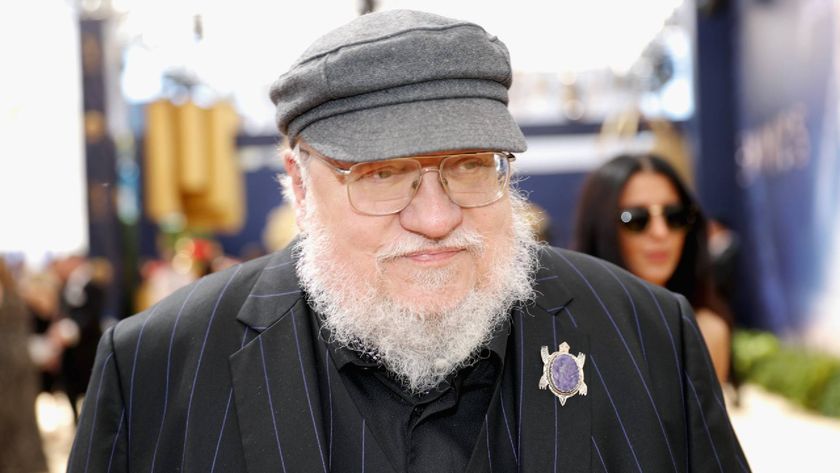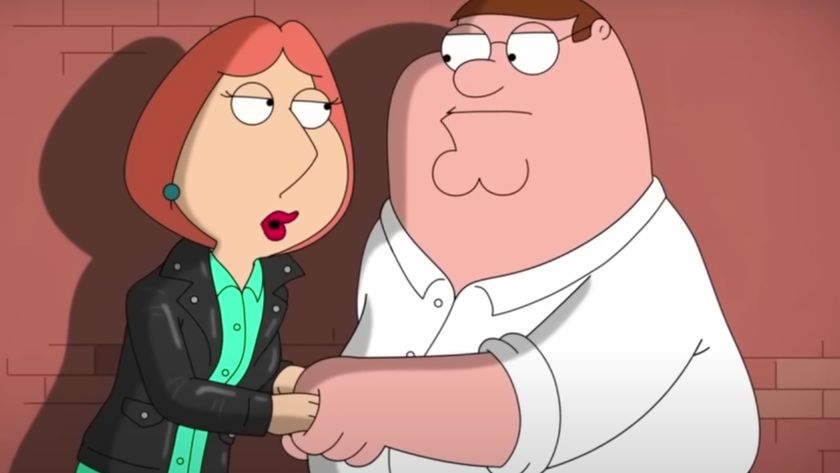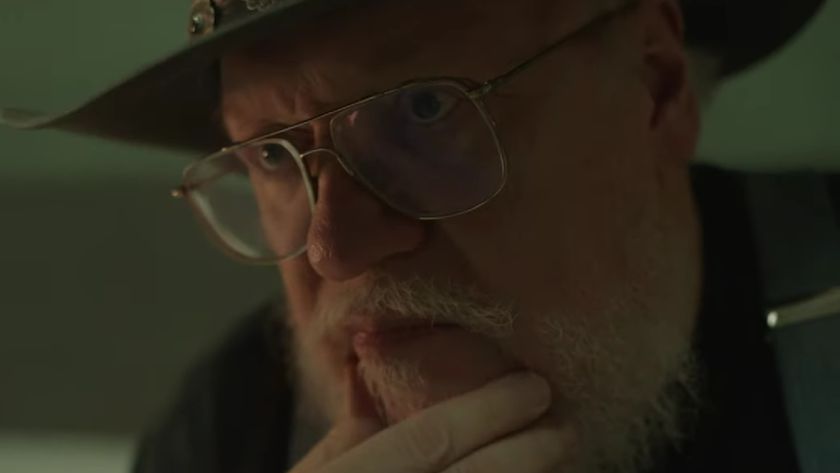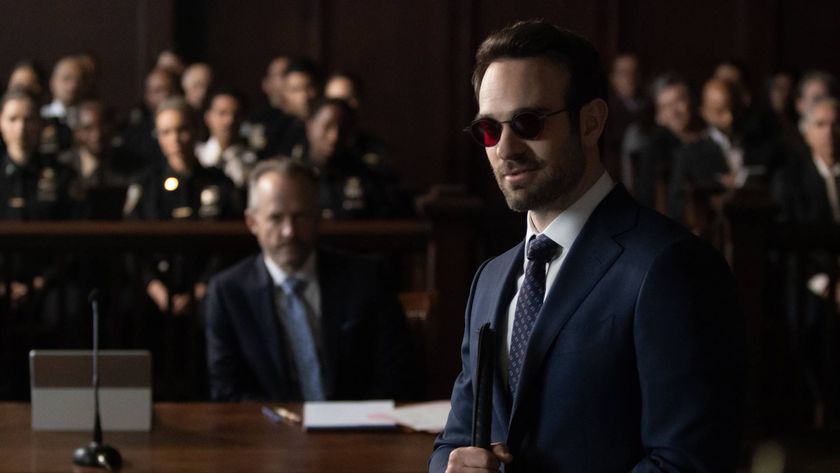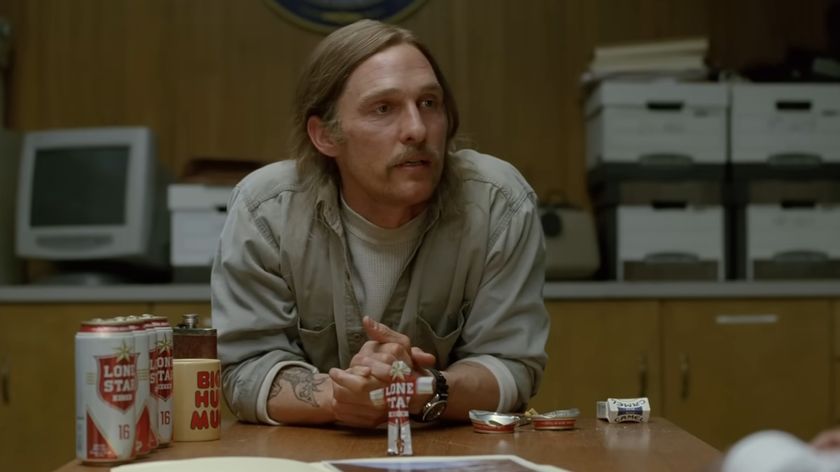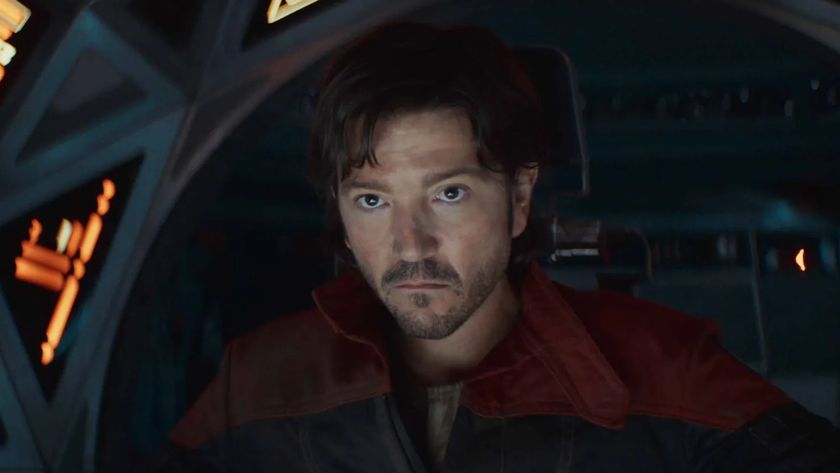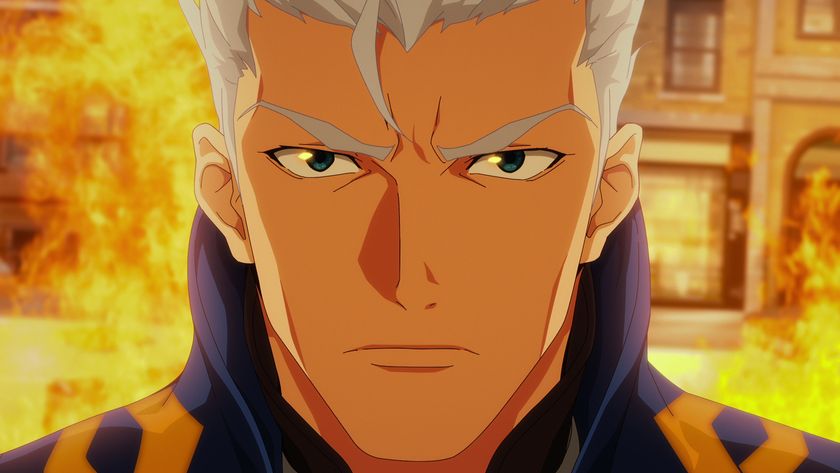Dave Gibbons is one of the quiet insurrectionaries of comic books. Watchmen – his 1985 collaboration with Northampton magus Alan Moore – was a revolution, a loving assault on the certainties of superheroics. Now Hollywood is bringing his masterwork to the screen with an improbably faithful big screen adaptation. But his career has been so much more than that genre-shaking graphic novel.
Over three decades Gibbons has lent his slick, kinetic yet characterful style to every pop-culture icon from Superman and Batman to Dan Dare and Doctor Who. “All I ever wanted to do was draw comics,” he says. “I never had an aspiration to be any other kind of artist. Telling stories was what I wanted to do, and I only ever wanted to draw well enough to tell a story, and make people believe it.”
SFX caught up with Gibbons at the Birmingham Comic Con. We bought him a muffin. It seemed the least we could do.
Watchmen obviously came from a deep love and fascination with superheroes. What was their primal appeal for you as a kid?
There’s something almost dreamlike about the world of the superhero. And American superheroes were in colour, of course. A lot of British comics were in black and white and a bit murky and a bit fusty, but American superhero comics had this clarity and this luminosity to them. And it wasn’t just the stories. It was the sense of them being an artifact from somewhere else. You’d get these advertisements for Schwinn bicycles and Tootsie Rolls… this whole other world. I remember the first time I went to New York. A lot of people would be thrilled to see the Empire State Building or the Statue of Liberty. Me, I was thrilled to see the water towers on the rooftops, just like Steve Ditko had drawn them in Spider-Man! It was this glimpse of a fabled land. For all I knew when I was a little kid they really did have superheroes in America. And there are lots of elements in the classic superheroes that appeal to a kid. The stories of Superman and Batman play to innate fears and desires in children. They’re both orphans, and the most terrifying thing a child can imagine is their parents dying. But then somehow afterwards you’re redeemed, or you have these powers… They’re very primal, almost unconscious. They were created by people who weren’t trying to create myths, but there’s something very raw and personal about superheroes.
I imagine there was a huge American influence on your art…
Yeah, it was primarily American comics that I was interested in. My favourite kind of artists were what I would call transatlantic artists – people like Joe Kubert, Wally Wood. I saw a lot of this American stuff in black and white to begin with, and I learnt to draw by copying it. I think my work has got a transatlantic feel, and it was fortunate that I was coming into my own when 2000 AD started up, because that was a fusion of both American and European influences. There was a whole generation of us – myself, Brian Bolland, Kevin O’Neill – who had grown up with the same influences. I think 2000 AD was the thing that changed everything. We finally had a clubhouse where we could work with our fellows, a group of artists almost in friendly competition with each other, not wanting to let the team down.
Sign up to the SFX Newsletter
Get sneak previews, exclusive competitions and details of special events each month!
And that’s where you got to do Dan Dare, of course. Did you feel the long shadow of Frank Hampson and the classic Eagle strip?
Oh yeah. Dan Dare was almost a supernatural kind of thing to read in the ‘50s. There was this tangibly real sense about Dan Dare, and that did imprint itself on me. And certainly when I came to do Watchmen I wanted to make everything about the world equally as real and consistent and bullet-proof. The circumstances under which Hampson produced Dan Dare were unique in the field of comics – comics has always been a really cheap operation, but Hampson had half a dozen assistants, a huge photographic budget, he produced two pages of artwork a week… this was the reason it looked so wonderful. When I got the chance to do Dan Dare I felt slightly cheated, because obviously they say to you ‘Hey Dave, do you want to draw Dan Dare?’ and you think ‘Oh yeah!’ and then you think ‘Oh God, that’s a heavy mantle to carry…’ The first version I did was very militaristic – it was like a military Star Trek. Then when we revived him again and I was promised it would be much closer to the original in that it had the Mekon and so on, it turned into some kind of quasi-superhero thing where he had this glove that contained ‘the power cosmic’… And that wasn’t very satisfactory.
Did you ever meet Frank Hampson?
I was lucky enough to meet him towards the end of his career. He was rather a bitter man, and that’s a great shame, because he wasn’t treated well, as so many people of his generation ultimately weren’t treated well. He didn’t own Dan Dare, despite the fact that he’d created everything about it. I was introduced to him rather mischievously by Dennis Gifford, who was a comics historian. He said ‘Oh Frank, this is Dave Gibbons, who’s drawing Dan Dare for 2000 AD…’ I said ‘It’s a great pleasure to meet you, Frank. I only wish I could do it a tenth as well as you did it.’ And he said ‘Oh, that’s alright, old son, we all have to make a living!’ And I felt that at least if I hadn’t been blessed then I’d been absolved of my sins! In a way I probably wish I’d left Dan Dare alone.
Did you always have your sights set on the States?
I did, though in the early days it seemed to be an impossible thing. It all seemed to be run by gangsters… people with Italian names who were obviously part of the mob! Or hard-bitten Kirbys and Ditkos. But the real corner-turning moment for me was when I bought a copy of Nick Fury Agent of SHIELD and I thought it was terribly drawn. And it was drawn by somebody called Barry Smith, from Britain. And I thought ‘hold on a minute, this is a guy who’s probably about the same age as me, from England… he’s drawing Marvel comics! It can be done! There is a way!’ So I went and bought 20 odd sheets of illustration board and redrew the whole story to show that I could do it better than Barry Smith. As it happened, I probably didn’t draw it better than him. In 1973 I went over to the States and took my samples with me, showed them around, didn’t get any work, though on the back of them I did get some work for British comics. And then several years later, in 1981, the Americans came over here and recruited me and some others to draw their comics. It was a long path, but there was a point at which I realised it was not an impossible path and that kept me going.
What did that wave of British talent bring to the American comics scene?
I think that sense of wonder, of being an observer of something ‘other’. Things that are everyday to Americans, like the watertowers on the roof, like fire plugs in the street, to me were objects of wonder. I think we saw things that were obvious to Americans in a completely different way, which was refreshing. And there’s a certain kind of anarchy that we bring to things. 2000 AD was very scurrilous and very sarcastic and satirical. I think we brought a little of that. The bloodline of American comics had got a little inbred and a little incestuous, and this was new blood from outside that would give the chinless wonders a chin again, if I can make a parallel with the Royal Family!
Do you think that only two Brits could have done Watchmen?
You can always play the what if game, but only Alan and I could have done Watchmen as it is. Again it’s timing. We were in the right place, we’d honed our talents. And just as American comics felt quirky and off-centre to me, Watchmen was quirky and off-centre to the bulk of American comics. It was just different enough to be intriguing.
But also familiar enough to be intriguing. It infiltrated and subverted.
Sure, and that was very much the idea. I deliberately drew Watchmen in a very accessible, no frills style, completely direct. Alan used this phrase: what a good story does is beckon you down the leafy path, and then once you’re in the shadows it beats you over the head with a baseball bat. When people read Watchmen they should think ‘oh yeah, this is just like a comic book… but hold on a minute! It feels wrong, it feels strange…’
There are two clashing sensibilities – the love of superheroes and the need to deconstruct them. Did those two creative impulses duke it out?
It’s good that you identify that there was a great love of superheroes, because that’s what a lot of people missed. We loved the idea of superheroes, we loved the characters. It was an act of love. There was nothing cynical about it, really. We said, let’s just be honest about these things that we love – what are we really looking at? If superheroes were real what would they really be like? And we tried to answer that question truthfully. And as much as there are depressing, dark and gritty passages – Rorshach looking into the fire and deciding that there is no God – it’s offset with Nite Owl in the basement with his Owlship and his wonderful gadgets. This was completely misunderstood by mainstream American comics, who thought right, let’s give everybody a psychological problem, let’s make everybody a drunk or a junkie… They completely missed the point.
Scary thought: we’re as far removed from Watchmen as Watchmen was from Lee and Kirby’s Fantastic Four. And yet people are still talking about ‘the groundbreaking Watchmen’. Are you disappointed that nothing equally revolutionary has come along since?
We were certainly disappointed that it was only the superficiality of Watchmen that was picked up on. There was a wonderful feeling in the mid 80s when there was Watchmen, Frank Miller’s The Dark Knight, Maus by Art Spiegelman… I compared it once to D-Day. ‘Finally we’ve made the beachhead! We’re on the beach! Here’s Watchmen, here’s Dark Knight, here’s Maus… come on guys!’ And nobody was there behind us!
Now Watchmen’s a movie. What kind of buzz do you get from seeing your art moving and three-dimensionalised?
It’s very strange. For me to sit in the dark and watch it unfold on the screen… Even being on the movie set, to actually see the Owlship, to be inside it, to shake hands with the Comedian… it’s almost ‘pinch me, I must be dreaming.’ When I saw a rough cut of the movie I was almost one step removed from it, thinking ‘is this real?’ It’s almost as if it existed and Alan and I did a comic book version of it.
Are you surprised it’s so faithful?
I suppose I am. I didn’t ever think it would be as well done as this. I thought they’d take the characters and mess them around. One reason I’ve been so vocally supportive of this movie is that from the beginning I’ve had a very, very good feeling about it, that the intentions of the movie makers were as good as you could reasonably expect. And having seen the movie, one of the things I’m most excited about is that it works as a movie. It’s not an attempt to slavishly recreate the comic. A lot of things have been recreated but only because they are the essence of it, they are essential to telling the story. And there are new scenes in it which were never in the graphic novel but work perfectly in terms of the film. They amalgamate elements, they shortcut. To some people that would be sacrilege, but to me it’s more important that it be a good movie and be true to the spirit and the message of Watchmen, rather than a slavish, detailed reconstruction. And the movie’s being made at exactly the right time, when the moviegoing audience is as familiar with superhero movies as comic book readers were back in the ‘80s. You can deconstruct without having to explain what it is that you’re deconstructing.
Alan Moore, of course, wants nothing to do with this film. Do you think he has no curiosity about it at all?
Well, if he says he hasn’t then I have to believe him. I would find it very hard not to have curiosity. Alan is a man of great principle and I’m sure if he says he’s not going to see it then he won’t see it.
Is it true he’s banned you from talking about it to him?
Yeah, we did reach that point. He said he was pleased that I was enjoying myself but that he couldn’t share my enthusiasm. And although he was always perfectly happy to talk to me and that I’d behaved impeccably as far as anything to do with Watchmen was concerned, he really didn’t want to talk about it with me anymore. And I respect that. I’m really sad that it’s come to that because creatively it was such a wonderful experience to share, and the fact that he’s now unable to enjoy it… But I do understand. Alan’s a unique figure in comics, and he’s had pressures put on him and expectations made of him and has almost become prey for so many people that he is put in very difficult positions. If he finds that he has more peace of mind by not being involved then I support him entirely.
It’s great to have someone with principles.
He doesn’t want his name on it and he doesn’t want the money. Someone asked me ‘Is Alan Moore really crazy?’ And I had to say no, he isn’t. He’s a very intelligent, thoughtful man who processes things in a very rational way. But to Hollywood, which is all about fame and money, they just can’t understand it. It does seem crazy in their value system. But as Alan said to me, Dave, you can’t buy entertainment like that… (laughs)
How do you view the relationship between comics and the film industry? Isn’t Hollywood just using it like a petri dish, growing ideas and seeing what works?
I think that works both ways as well. I think there are lots of people doing comics who think right, let’s get a quick miniseries out and sell it to the movies. I think you have to respect that they are two different mediums. Obviously a Watchmen movie, no matter how well it’s done, is a hybrid thing, but I think movies have always dealt in legend and fable and archetypal situations and stories. I was going to say that one of the unique things about Watchmen is you can go back and read it again, you can stop, you can retrace your steps – but of course nowadays with DVD players in every home you can do that too; you can freeze-frame, you can step back. I find it inconceivable that anybody who buys the Watchmen DVD will only watch it once. I think people are going to do exactly what they do with the book; they’re going to put it aside, come back to it and find more stuff. And of course we’re going to get thousands and thousands of new readers looking at the original work. If nothing else I see that as a very positive thing.
Watchmen opens 6 March. This interview comes complete with a selection of rare Gibbons art from his own archives in SFX 180.
Nick Setchfield
SFX Magazine is the world's number one sci-fi, fantasy, and horror magazine published by Future PLC. Established in 1995, SFX Magazine prides itself on writing for its fans, welcoming geeks, collectors, and aficionados into its readership for over 25 years. Covering films, TV shows, books, comics, games, merch, and more, SFX Magazine is published every month. If you love it, chances are we do too and you'll find it in SFX.
